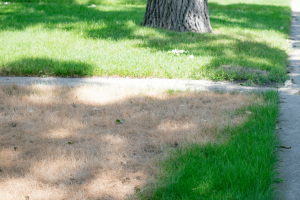Winter Watering on the Front Range
Our often dry, windy winters here on the Front Range can be especially tough on landscaping plants such as perennials, trees, shrubs, and lawns. Most plants need moisture throughout the winter to prevent root damage, so developing a winter watering schedule can help to protect your landscaping.
If roots are damaged over the winter, the “winter kill” is not obvious until summer. A plant or lawn may green up nicely in the spring, but in the first hot days of summer, a plant with damaged roots will struggle to take up enough water. This affects the health of the entire plant and can result in the browning of foliage (especially in evergreens and lawns). A weakened plant is more susceptible to pest and disease damage, and in severe cases, the entire plant may die from winter kill. Because our winters often lack consistent precipitation, many plants will benefit from supplemental winter watering.


What plants benefit from winter watering?
Nearly all plants will benefit from winter watering. However, the following plants are especially sensitive to drought injury throughout the winter.
- Recent Transplants
- Plants that are less established have smaller root systems and need more supplemental water to thrive.
- According to Colorado State University Extension, trees take one year to establish for each inch of trunk diameter at planting.
- Bare root plants take longer to establish than container plants.
- Plants transplanted later in the season take longer to establish.
- Evergreens
- Because evergreens retain their needles, they still transpire throughout the winter. Without adequate soil moisture to replace this water loss, evergreens are at a higher risk for winter burn.
- Evergreens at highest risk include arborvitae, boxwood, fir, Manhattan euonymus, non-native pines, Oregon grape-holly, spruce, and yew.
- To help limit desiccation, some evergreens can be treated with a product such as Wilt Pruf® or Bonide Wilt-Stop®. Read the product label for uses and instructions.
- Deciduous Trees and Shrubs with shallow root systems
- Woody plants with shallow root systems are more likely to dry out because they cannot pull water from deep in the ground.
- These include alders, European white and paper birches, dogwoods, hornbeams, lindens, mountain ashes, willows and several varieties of maple including Norway, silver, red, Rocky Mountain, and hybrid maples.
- Herbaceous Perennials and Ground Covers
- Even established perennials and ground covers can suffer from winter kill, especially those without wind protection and those with south or west exposures that experience more freezing and thawing.
- Lawns
- Newly established lawns are especially at risk for winter kill as well as those with south or west exposures.
When should I winter water?
Most plants will benefit from winter watering from October through March.
According to Colorado State University Extension, water one to two times per month during dry periods without snow cover. Windy or sunny sites (those with south or west exposures) dry out quicker and will require more water.
Only water when air temperatures are above 40°F and the soil is not frozen or covered in snow.
Water mid-day or earlier to ensure the water has time to fully soak in before freezing at night. Test soil moisture before watering by inserting a probe or screwdriver into the soil. If the screwdriver goes in easily, watering is not necessary. However, if it is difficult to push the screwdriver in after a few inches, watering is necessary.
What is the best way to apply water during winter?
While water can be applied by hand, typically it is most efficient to water with a soaker hose, drip hose or sprinkler that attaches to a hose. (Do not use an in-ground sprinkler system as these should stay winterized until spring.)
Trees can also be watered using a deep-root fork or needle that is inserted no deeper than eight inches into the soil in multiple locations throughout the dripline and outside of it. As with watering in the summer, it is important to allow water to slowly soak into the soil. This results in deeper penetration and prevents runoff. For trees, water should penetrate to a depth of 12 inches.
How much water do my plants need?
Mulch is crucial to helping soil retain moisture. The following recommendations assume that all plants have at least two inches of mulch. Keep in mind that most sprinklers deliver approximately 2 gallons of water per minute.
Trees
- Apply at least 10 gallons of water for each diameter inch of the tree
- Water once a month (twice a month for newly planted trees)
- Water from the edge of the branches halfway to the trunk, and then two to three times that distance from the edge of the branches outward
Shrubs
- Newly Planted: Apply at least 5 gallons of water twice a month
- Small, established (less than 3 feet tall): Apply at least 3 gallons of water once a month
- Large, established (more than 6 feet tall): Apply at least 10 gallons of water once a month
- Water within the dripline and around the base
Herbaceous Perennials
- Water requirements vary based on level of establishment and size of the plant
- As a general guideline, apply half the amount of water that would be applied in a typical summer watering session once a month
Lawns
- Water lawns if there has been no precipitation for three weeks and the lawn has a south or west exposure
- Apply half the amount of water that would be applied in a typical summer watering session
Resources
https://water.unl.edu/article/lawns-gardens-landscapes/winter-watering
Back to Blog